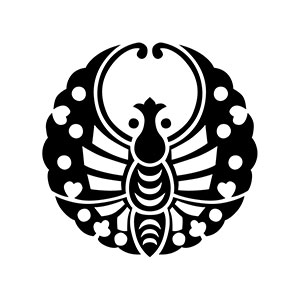Bitchu Matsuyama Domain (2/2)A small domain ruled by five families

Ikeda family crest "agewing butterfly"
- Article category
- History of the domain
- domain name
- Bitchu Matsuyama Domain (1617-1871)
- Affiliation
- Okayama Prefecture
- Related castles

Bitchu Matsuyama Castle
Existing castle tower
- related castles
After that, the Itakura family served as the feudal lord for four generations, but nothing particularly noteworthy happened.
Many of the castle lords were sickly, and all of them, including Katsumasa Itakura, the fourth generation lord of the Itakura family, died of illness in their 20s or 30s.
Katsumasa Itakura served as a temple magistrate during the shogunate, and founded the domain school Yushukan during the domain administration.
At the age of 43, due to illness, he handed over his estate to his fourth son, Masaru Itakura, and retired, but three years after becoming the lord of the domain, he suddenly died of heat stroke at the young age of 21.
Katsutoki Itakura, the sixth lord of the domain who succeeded him, worsened the domain's finances due to his extravagance.
Since he had no children, he adopted Katsushige Itakura, the eighth son of Sadanaga Matsudaira, the lord of the Mutsu-Shirakawa domain, and succeeded him as the seventh lord of the domain.
Katsushige Itakura was a man of great intelligence, and in addition to selecting Yamada Katsutani, a scholar of yo-mei-scholars who had a background in agriculture and commerce, as the principal of the domain school, he also succeeded in rebuilding the domain's finances by starting a new industry.
This achievement was recognized by the shogunate and he was appointed as a performer and a temple and shrine magistrate, but when the Ansei Great Prison occurred, he was dismissed because he spoke out against the harsh punishment of the chief elder, Ii Naosuke.
However, after Naosuke's death in 1861, he returned as a performer and temple magistrate, and was later promoted to roju.
After becoming Roju, he became a close aide to the 14th Shogun, Iemochi Tokugawa, and was involved in issues such as compensation for the Namamugi Incident and the inability to comply with the Joi Edict received from Emperor Komei.
Afterwards, he received the deep trust of the last shogun, Yoshinobu Tokugawa, and was appointed as the chief councilor and treasurer.
As one of the important figures of the shogunate, Katsushige Itakura worked hard to realize the restoration of imperial rule.
He accompanied Yoshinobu Tokugawa in the battles of Toba and Fushimi, which was a war with the new government army, but because of this, he was seen as an ``enemy of the Imperial Court'' by the new government army, and the Bicchu Matsuyama domain found itself in a difficult situation.
The vassals made a desperate move to protect the Bicchu Matsuyama domain by suddenly appointing Katsuzuke Itakura, the grandson of Katsumasa Itakura, the fourth lord of the domain, as the new lord and forcibly removing Katsushige Itakura from his position as lord.
The Bitchu Matsuyama domain had its fief of 50,000 koku reduced to 20,000 koku, but it entered the Meiji era without being involved in the war.
Katsushige Itakura only served as a link until Katsushige Itakura was pardoned by the new government, but Katsushige Itakura later returned to his homeland and once again made his vassals swear loyalty to Katsushige Itakura.
Bicchu Matsuyama domain after the Meiji period
Katsusuke Itakura later became the governor of the domain, but was dismissed from his position due to the abolition of the domain and the establishment of prefectures, and went to Tokyo, where he was decorated as a viscount and served as the head of the Ueno Toshogu Shrine, where he died at the age of 51.
In the Meiji period, Katsushige Itakura became a priest at Ueno Toshogu Shrine, and with the help of his adopted son Katsushi Itakura and others, he established the 86th National Bank (currently Bank of China).
Furthermore, Katsushige Itakura was described by Kaishu Katsu and the British diplomat Ernest Sato as ``a good man'' and ``in his time, he would have been called a great prince,'' and records of this have been passed down to this day.
By the way, Katsunori Itakura, a mountaineer in the early Showa period who popularized skiing in Japan, is the biological son of Katsunori Itakura.
summary
Although the Bicchu Matsuyama domain is a small domain in Okayama Prefecture, it has produced several feudal lords who have risen to important positions in the shogunate. In particular, Katsushige Itakura, the 7th feudal lord, was deeply involved in historical events such as the restoration of imperial rule as a close aide to the 14th and 15th shoguns.
The Itakura family still exists today, and Shigenori Itakura, the 19th generation head of the family, served as a torchbearer in Takahashi City before the 2020 Tokyo Olympics.
Although he currently lives in Tokyo, he regularly returns to Takahashi City, Okayama Prefecture to work on PR for the area.
Reread the article on Bicchu Matsuyama Domain
- related castles

- WriterAYAME(Writer)I am a writer who loves history, focusing on the Edo period. My hobbies are visiting historical sites, temples and shrines, and reading historical novels. If there is a place you are interested in, you can fly anywhere. I'm secretly happy that the number of sword exhibitions has increased recently thanks to the success of Touken Ranbu.



